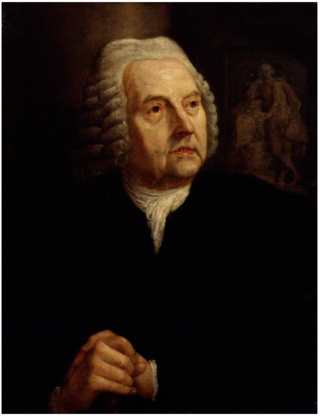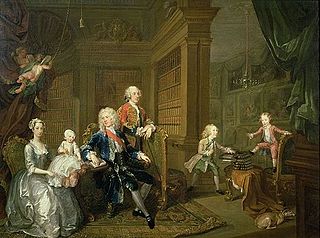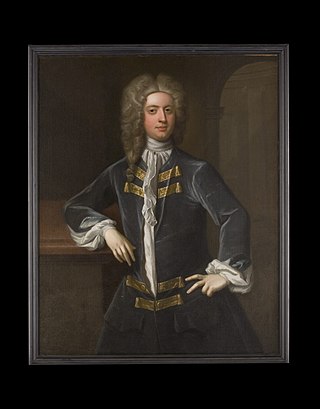
Sir Thomas Reeve, PC (1673 –19 January 1737) was a British justice.

Sir Thomas Reeve, PC (1673 –19 January 1737) was a British justice.
He was the son of Richard Reeve, and was matriculated to Trinity College, Oxford in 1688 at the age of 15, joining Inner Temple in 1690. [1] In 1698 he was called to the Bar, migrating to Middle Temple in 1713. He was called to the Inn bench in 1720, and served as treasurer in 1728. In 1717 he became a King's counsel, and in 1722 became attorney-general of the Duchy of Lancaster. He was at this point one of the most prolific barristers in Britain. An analysis of records show that in 1720 he was appearing in more cases than any other barrister in the Court of the King's Bench. He was appointed a judge in the King's Bench on 18 November 1723. [2]
On 17 April 1733, [3] he became a Puisne justice of the Court of Common Pleas, and was created a Serjeant-at-law at the same time to satisfy the minimum requirements for the office. After the death of Sir Robert Eyre in office in 1735 Reeve was rumoured to be succeeding him, but had competition in the form of Alexander Denton, who he had previously succeeded as attorney-general of the Duchy of Lancaster; Denton was rejected on grounds of ill-health, however, and Reeve was promoted on 26 January 1736, and knighted at the same time. [4] He was appointed to the Privy Council shortly after. [5] He died in office within a year on 19 January 1737, and was buried in Temple Church on 28 January. He was at the time of his death very wealthy, including over £22,000 in personal property, as well as land in Berkshire and London; he was apparently courted by Lord Sidney Beauclerk, an infamous fortune-seeker, who hoped to be given a legacy, although without success. He was married to Annabella Topham, whose brother Richard Topham was Keeper of the Records at the Tower of London; Beauclerk later succeeded in getting the estate of Richard in and around Windsor and Old Windsor.
The memorial to Sir Thomas and his wife (with busts) stands in John the Baptist Church in Windsor and is by Peter Scheemakers. [6]

Peter Scheemakers or Pieter Scheemaeckers II or the Younger was a Flemish sculptor who worked for most of his life in London. His public and church sculptures in a classicist style had an important influence on the development of modern sculpture in England.

Richard Temple, 1st Viscount Cobham was a British soldier and Whig politician. After serving as a junior officer under William III during the Williamite War in Ireland and during the Nine Years' War, he fought under John Churchill, 1st Duke of Marlborough, during the War of the Spanish Succession. During the War of the Quadruple Alliance Temple led a force of 4,000 troops on a raid on the Spanish coastline which captured Vigo and occupied it for ten days before withdrawing. In Parliament he generally supported the Whigs but fell out with Sir Robert Walpole in 1733. He was known for his ownership of and modifications to the estate at Stowe and for serving as a political mentor to the young William Pitt.

Charles FitzRoy, 2nd Duke of Grafton, was a British peer and politician.

Charles Spencer, 3rd Duke of Marlborough,, styled as The Honourable Charles Spencer between 1706 and 1729 and as The Earl of Sunderland between 1729 and 1733, was a British soldier, nobleman, and politician from the Spencer family. He briefly served as Lord Privy Seal in 1755. He led British forces during the Raid on St Malo in 1758.

George Cholmondeley, 3rd Earl of Cholmondeley,, styled as Viscount Malpas from 1725 to 1733, was a British Whig politician and nobleman who sat in the House of Commons from 1724 to 1733.

Topham Beauclerk was a celebrated wit and a friend of Dr Johnson and Horace Walpole.

James Parke, 1st Baron Wensleydale PC was a British barrister and judge. After an education at The King's School, Macclesfield and Trinity College, Cambridge he studied under a special pleader, before being called to the Bar by the Inner Temple in 1813. Although not a particularly distinguished barrister, he was appointed to the Court of King's Bench on 28 November 1828, made a Privy Counsellor in 1833 and, a year later, a Baron of the Exchequer. He resigned his post in 1855, angered by the passing of the Common Law Procedure Acts, but was recalled by the government, who gave him a peerage as Baron Wensleydale of Walton to allow him to undertake the judicial functions of the House of Lords, a role he fulfilled until his death on 25 February 1868.
Admiral Vere Beauclerk, 1st Baron Vere, known as Lord Vere Beauclerk until 1750, was a Royal Navy officer, British peer and politician who sat in the House of Commons for 24 years from 1726 to 1750. After serving various ships in the Mediterranean and then commanding the third-rate HMS Hampton Court, he joined the Board of Admiralty, ultimately serving as Senior Naval Lord.

Robert Raymond, 1st Baron Raymond, was an English judge, politician and peer who sat in the British House of Commons between 1710 and 1724.

Lord Sidney Beauclerk was a British politician who sat in the House of Commons from 1733 to 1744. He acquired a reputation as a fortune hunter.
Events from the year 1668 in England.
Sir Thomas Abney was an English barrister and later judge. He was baptized at Willesley, Derbyshire on 30 April 1691 and was the younger son of Sir Edward Abney, by his second wife, Judith, daughter and co-heir of Peter Barr, of London.
Sir John Strange was a British politician and judge.

Sir Wilfrid Lawson, 3rd Baronet of Isell FRS was a British politician who sat in the House of Commons from 1718 to 1737.

John Harper was an English actor. He was known for comic parts.
Rogers Holland of Chippenham, Wiltshire was an English lawyer and Whig politician who sat in the House of Commons from 1727 to 1737.
Richard Topham (1671–1730) was an English landowner and politician, Member of Parliament for New Windsor from 1698 to 1713. He is known also as a collector.
William Mills (1701-1750) was a British stage actor.

Sir Derek Anthony Sweeting is a British High Court judge.